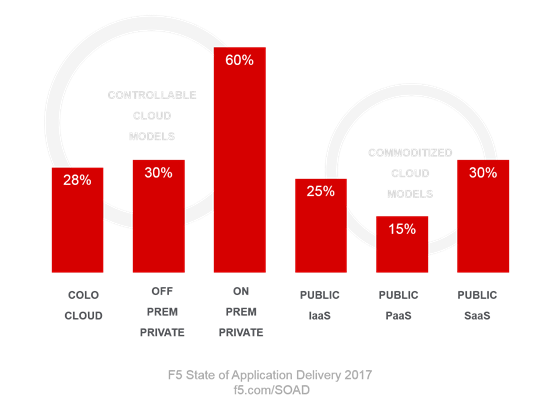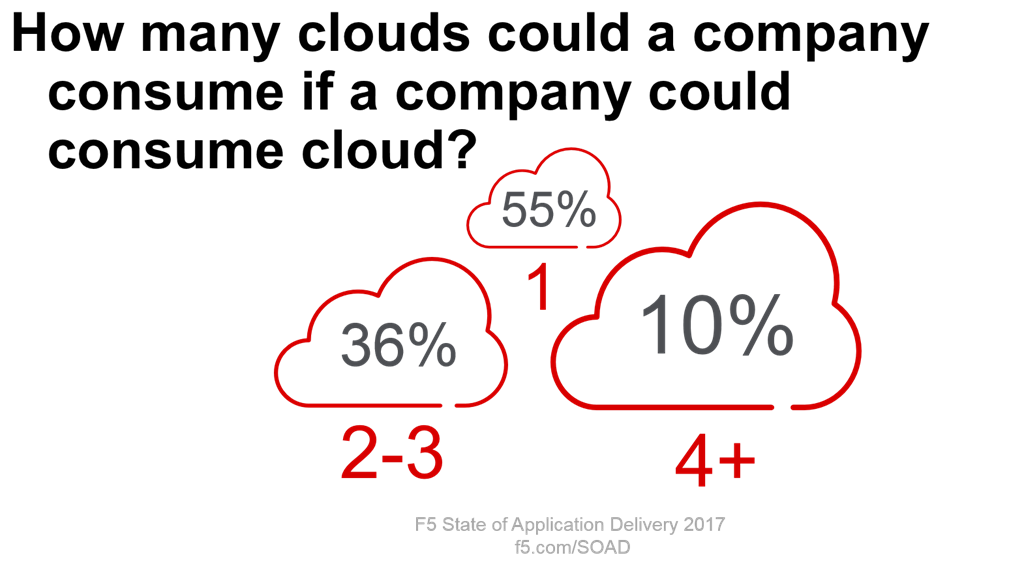There are Only Two Types of Clouds: Those you control and those you don’t
Cloudy insights from the State of Application Delivery 2017
Control. We use that word a lot. Control yourself! Control your own destiny! Control your financial future. Find out how!
Control is a simple word that connotes a very powerful concept: that of taking the reins and directing where and how something happens.
In the enterprise, we’re seeing that concept of control is an important factor when it comes to cloud. For some, that may be surprising. For others – especially those who’ve been reading along over the past ten years – you might not. Regardless, the reality is that enterprise organizations are choosing cloud models they can control over those they cannot. That doesn’t mean they aren’t cloud models based largely on commoditization of resources (IaaS) or function (SaaS), it just means that they tend to choose other models first, driven in part by the nature of the applications being deployed.

When we asked over 2100 IT professionals across the globe, working in every industry, and in every role within IT, about the use of various cloud models within their organizations, the results overwhelming pointed to a preference for those models that engender control.
This is not about location, mind you. While on-premises private cloud was resoundingly preferred by respondents, it was not without significance that colo cloud and off-premises private cloud – both which rely on deployment of apps and infrastructure off site – were also tagged as being in use. More often than other “public” models IaaS and PaaS. And SaaS, of course, continues to exhibit strong use in enterprises of all sizes and in all industries. All off-premises, too.
So it isn’t location that’s troublesome for companies, but rather limitations on visibility and control necessarily required by models that are based largely on the concept of commoditization.
Commoditization implies a high level of standardization, and standardization imposes restrictions on deviation. Customization might be possible, but only at the application layer. The infrastructure and thus a good portion of the architecture is untouchable by those who subscribe to such services.
And with good reason. If everyone could muck with the network layers in Amazon or Azure, for example, it would wreak havoc across its entire system, and incur increasing costs that would likely be passed on to customers. Disruptions would occur and eventually neighboring apps and systems would suffer outages (or worse) that would lead to deteriorating value of public cloud that could make its use non-viable.
The standardization imposed by public cloud models is necessary and a good thing. It enables unparalleled cost savings, a stable environment, and a consistent experience. All good things. Unless organizations desire a higher level of control that includes those layers of the infrastructure typically abstracted and controlled by the cloud provider.
That’s likely why we’re seeing such high usage of cloud models that are ‘controllable’. Off-premises private (think Amazon VPC) have long been available as a response to organization’s greater need for control. But even they have limitations (because commoditization, you see) which is why colo cloud has become such a popular option in such a short period of time. In combining the need for control with the choice of public IaaS cloud, colo cloud providers have hit upon the right mix of control and commodity to provide enterprises with yet another item on the cloud model menu.
These competing needs – affordable, commoditized resources and functions versus full-stack control – are being met by organizations not by any single model. You’ll note the percentages in the chart add up to more than 100 percent. That’s because respondents selected all models that apply. While the average number of cloud models in use was 1.8.

In fact, if we look at how many different models organizations are using, we’ll find that nearly half (46%) are using more than 2. A non-trivial ten percent are using four or more different models to satisfy these varying needs.
And use of public (IaaS) cloud is growing. Our survey results indicated a growing preference for deploying every category of app services in public (IaaS) clouds. Given that you generally don’t deploy said app services without an app to support, secure, or deliver, it’s a safe conclusion to say that app deployments in public (IaaS) clouds are in fact increasing comparably.
Which means I’d expect to see commensurate increases in the number of cloud models in use in future surveys. That’s due in part to the types of applications being deployed in the various models. Disposable apps, renewable apps, mobile apps, and the like are innately well suited to the public cloud both because of its accessibility, scalability, and cost model. And we see that reflected in our results as well (if you haven’t gotten a copy of that yet, you can do so right here) in the deployment preferences for applications indicated by respondents.
What this all means is that we’re entering an era of multi-cloud. While 55% of respondents still use only one cloud model (and it’s largely on-premises private), that’s rapidly changing as organizations increase the rate at which they’re adopting other cloud models. But the fact remains that enterprises will continue to choose cloud providers carefully, largely based on whether or not they need control over their entire architecture.
There may be many cloud ‘models’, but in the end there really are only two types of cloud: those that provide control and those based on the premise of commoditization. And enterprises are consuming both in copious quantities.
